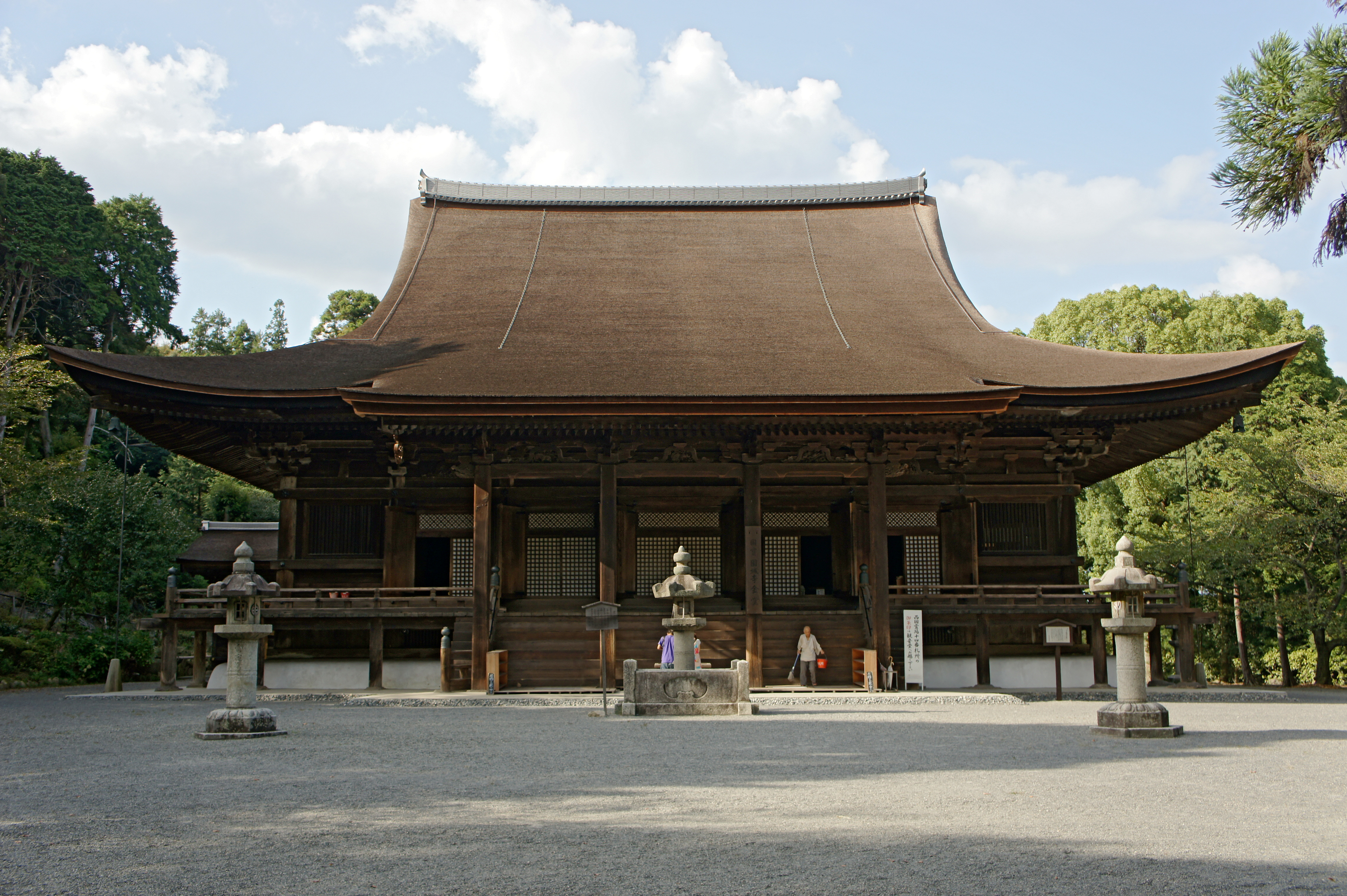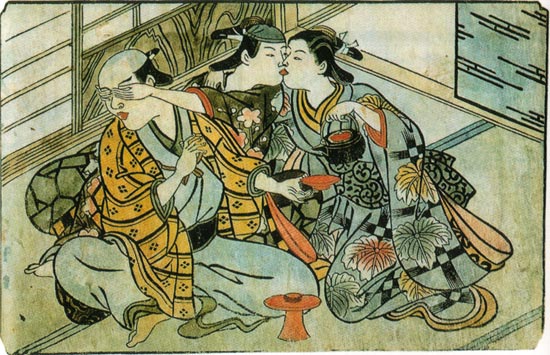|
Miidera (play)
''Miidera'' was a Noh play centred around a mad woman, and her search for her son at the temple complex of Mii-dera near Kyoto. Plot Driven mad by the loss of her young son, possibly abducted as a boy prostitute, the heroine is urged in a dream to seek him at Miidera temple. There the woman is much impressed by the temple bell, and recounts a long list of episodes involving temple bells. When she finally draws attention to herself by striking the bell, she is recognised by and reunited with her son - the aesthete Oswald Valentine Sickert considering that "The sounding of the bell is the hinge of everything, a thing of great sentiment". Literary links An early haiku quotes the play: "Hey there, wait a moment / before you strike the bell /at the cherry blossoms". See also *Kagema *Kannon *Nāga The Nagas (IAST: ''nāga''; Devanāgarī: नाग) are a divine, or semi-divine, race of half-human, half-serpent beings that reside in the netherworld (Patala), and can occasion ... [...More Info...] [...Related Items...] OR: [Wikipedia] [Google] [Baidu] |
Mii-dera
, formally called , is a Buddhist temple in Japan located at the foot of Mount Hiei, in the city of Ōtsu in Shiga Prefecture. It is a short distance from both Kyoto, and Lake Biwa, Japan's largest lake. The head temple of the Jimon sect of Tendai, it is a sister temple to Enryaku-ji, at the top of the mountain, and is one of the four largest temples in Japan. Altogether, there are 40 named buildings in the Mii-dera complex. Mii-dera is temple 14 in the Saigoku Kannon Pilgrimage. History Founding, and feuds Onjō-ji was founded in the Nara period. The temple was founded in 672 following a dispute over Imperial succession. Emperor Tenji had died, and his son was killed by Tenji's brother, who was then enthroned as Emperor Tenmu. Temmu founded Onjō-ji in honor and memory of his brother. The name ''Mii-dera'' ("Temple of Three Wells") came about nearly two centuries later. It was given this name by Enchin, one of the earliest abbots of the Tendai Sect. The name comes from ... [...More Info...] [...Related Items...] OR: [Wikipedia] [Google] [Baidu] |
Kyoto
Kyoto (; Japanese: , ''Kyōto'' ), officially , is the capital city of Kyoto Prefecture in Japan. Located in the Kansai region on the island of Honshu, Kyoto forms a part of the Keihanshin metropolitan area along with Osaka and Kobe. , the city had a population of 1.46 million. The city is the cultural anchor of a substantially larger metropolitan area known as Greater Kyoto, a metropolitan statistical area (MSA) home to a census-estimated 3.8 million people. Kyoto is one of the oldest municipalities in Japan, having been chosen in 794 as the new seat of Japan's imperial court by Emperor Kanmu. The original city, named Heian-kyō, was arranged in accordance with traditional Chinese feng shui following the model of the ancient Chinese capital of Chang'an/Luoyang. The emperors of Japan ruled from Kyoto in the following eleven centuries until 1869. It was the scene of several key events of the Muromachi period, Sengoku period, and the Boshin War, such as the Ōnin War, the Ho ... [...More Info...] [...Related Items...] OR: [Wikipedia] [Google] [Baidu] |
Male Prostitution
Male prostitution is the act or practice of men providing sexual services in return for payment. It is a form of sex work. Although clients can be of any gender, the vast majority are older males looking to fulfill their sexual needs. Male prostitutes have been far less studied than female prostitutes by researchers. Even so, male prostitution has an extensive history including regulation through homosexuality, conceptual developments on sexuality, and the HIV/AIDS, monkeypox, and COVID-19 epidemic impact. In the last century, male sex work has seen various advancements. Popularizing new sexual acts, methods of exchange, and carving out a spot in cinema. Today, there is a focus on improving the work conditions, treatment, and mental health of male sex workers. Terminology The terms used for male prostitutes generally differ from those used for females. Some terms vary by clientele or method of business. Where prostitution is illegal or taboo, it is common for male prostitutes t ... [...More Info...] [...Related Items...] OR: [Wikipedia] [Google] [Baidu] |
Aesthete
Aestheticism (also the Aesthetic movement) was an art movement in the late 19th century which privileged the aesthetic value of literature, music and the arts over their socio-political functions. According to Aestheticism, art should be produced to be beautiful, rather than to serve a moral, allegorical, or other didactic purpose, a sentiment exemplified by the slogan "art for art's sake." Aestheticism originated in 1860s England with a radical group of artists and designers, including William Morris and Dante Gabriel Rossetti. It flourished in the 1870s and 1880s, gaining prominence and the support of notable writers such as Walter Pater and Oscar Wilde. Aestheticism challenged the values of mainstream Victorian culture, as many Victorians believed that literature and art fulfilled important ethical roles. Writing in ''The Guardian'', Fiona McCarthy states that "the aesthetic movement stood in stark and sometimes shocking contrast to the crass materialism of Britain in the 1 ... [...More Info...] [...Related Items...] OR: [Wikipedia] [Google] [Baidu] |
Oswald Sickert
Oswald Adalbert Sickert (21 February 1828 – 11 November 1885) was a Danish artist, considered a painter of dramatic genre, landscapes and an engraver from the English school. Early life He was born in Altona, then in Denmark, the son of Johann Jürgen Sickert (1803–1864), who was also a painter and engraver. He received his formal training from his father and at the Copenhagen Académie in Denmark from 1844 to 1846. In 1852, he traveled to Munich to complete his studies, and thereafter to Paris for six months, before moving permanently to London. Career He left Munich to settle in England at the time of the Great Exhibition, Oswald's work having been recommended by Freiin Rebecca von Kreusser to Ralph Nicholson Wornum, who was Keeper of the National Gallery in London at the time. He opened a studio in London and eventually became a British citizen. His successful career as an artist included exhibitions at the British Institute, Grosvenor Gallery and several other Lon ... [...More Info...] [...Related Items...] OR: [Wikipedia] [Google] [Baidu] |
Haiku
is a type of short form poetry originally from Japan. Traditional Japanese haiku consist of three phrases that contain a ''kireji'', or "cutting word", 17 '' on'' (phonetic units similar to syllables) in a 5, 7, 5 pattern, and a ''kigo'', or seasonal reference. Similar poems that do not adhere to these rules are generally classified as ''senryū''. Haiku originated as an opening part of a larger Japanese poem called renga. These haiku written as an opening stanza were known as ''hokku'' and over time they began to be written as stand-alone poems. Haiku was given its current name by the Japanese writer Masaoka Shiki at the end of the 19th century. Originally from Japan, haiku today are written by authors worldwide. Haiku in English and haiku in other languages have different styles and traditions while still incorporating aspects of the traditional haiku form. Non-Japanese haiku vary widely on how closely they follow traditional elements. Additionally, a minority movement withi ... [...More Info...] [...Related Items...] OR: [Wikipedia] [Google] [Baidu] |
Roger Scruton
Sir Roger Vernon Scruton (; 27 February 194412 January 2020) was an English philosopher and writer who specialised in aesthetics and political philosophy, particularly in the furtherance of traditionalist conservative views. Editor from 1982 to 2001 of ''The Salisbury Review'', a conservative political journal, Scruton wrote over 50 books on philosophy, art, music, politics, literature, culture, sexuality, and religion; he also wrote novels and two operas. His most notable publications include ''The Meaning of Conservatism'' (1980), ''Sexual Desire'' (1986), ''The Aesthetics of Music'' (1997), and ''How to Be a Conservative'' (2014). He was a regular contributor to the popular media, including ''The Times'', ''The Spectator'', and the ''New Statesman''. Scruton embraced conservatism after witnessing the May 1968 student protests in France. From 1971 to 1992 he was a lecturer and professor of aesthetics at Birkbeck College, London, after which he held several part-time academic ... [...More Info...] [...Related Items...] OR: [Wikipedia] [Google] [Baidu] |
Kagema
is a Japanese term for historical young male sex workers. were often passed off as apprentice kabuki actors (who often engaged in sex work themselves on the side) and catered to a mixed male and female clientele. For male clients, the preferred service was anal sex, with the client taking the penetrative role; homosexual fellatio is almost unmentioned in Edo period (1603–1867) documents. who were not affiliated with an actual kabuki theatre could be hired through male brothels or teahouses specializing in . Such institutions were known as . typically charged more than female sex workers of equivalent status, and experienced healthy trade into the mid-19th century, despite increasing legal restrictions that attempted to contain sex workers (both male and female) in specified urban areas and to dissuade class-spanning relationships, which were viewed as potentially disruptive to traditional social organization. Many such sex workers, as well as many young kabuki actors, wer ... [...More Info...] [...Related Items...] OR: [Wikipedia] [Google] [Baidu] |
Kannon
Guanyin () is a Bodhisattva associated with compassion. She is the East Asian representation of Avalokiteśvara ( sa, अवलोकितेश्वर) and has been adopted by other Eastern religions, including Chinese folk religion. She was first given the appellation of "Goddess of Mercy" or "Mercy Goddess" by Jesuit missionaries in China. Guanyin is short for Guanshiyin, which means " he One WhoPerceives the Sounds of the World." On the 19th day of the sixth lunar month, Guanyin's attainment of Buddhahood is celebrated. Some Buddhists believe that when one of their adherents departs from this world, they are placed by Guanyin in the heart of a lotus, and then sent to the western pure land of Sukhāvatī. Guanyin is often referred to as the "most widely beloved Buddhist Divinity" with miraculous powers to assist all those who pray to her, as is mentioned in the ''Pumen chapter'' of ''Lotus Sutra'' and ''Kāraṇḍavyūha Sūtra''. Several large temples in East Asia ... [...More Info...] [...Related Items...] OR: [Wikipedia] [Google] [Baidu] |
Nāga
The Nagas (IAST: ''nāga''; Devanāgarī: नाग) are a divine, or semi-divine, race of half-human, half-serpent beings that reside in the netherworld (Patala), and can occasionally take human or part-human form, or are so depicted in art. A female naga is called a Nagi, or a Nagini. According to legend, they are the children of the sage Kashyapa and Kadru. Rituals devoted to these supernatural beings have been taking place throughout South Asia for at least 2,000 years. They are principally depicted in three forms: as entirely human with snakes on the heads and necks, as common serpents, or as half-human, half-snake beings in Hinduism, Buddhism, and Jainism. ''Nagaraja'' is the title given to the king of the nagas. Narratives of these beings hold cultural significance in the mythological traditions of many South Asian and Southeast Asian cultures, and within Hinduism and Buddhism, they are the ancestral origins of the Nagavanshi Kshatriyas. Etymology In Sanskrit, a () ... [...More Info...] [...Related Items...] OR: [Wikipedia] [Google] [Baidu] |








